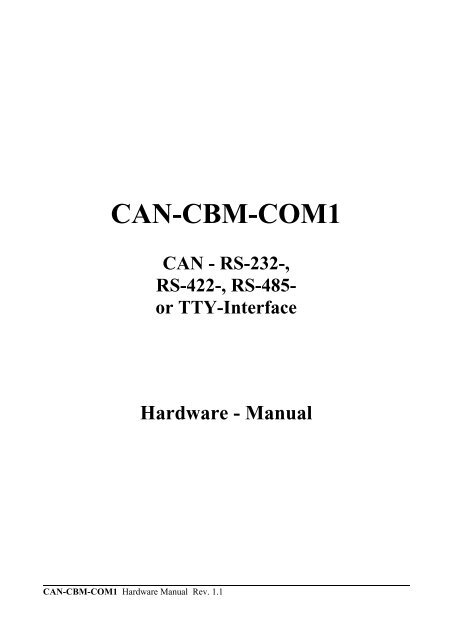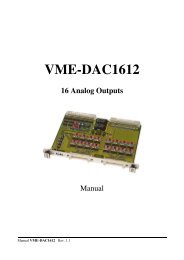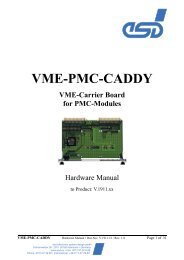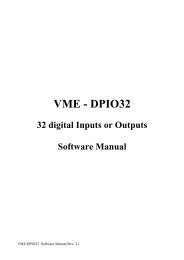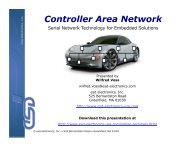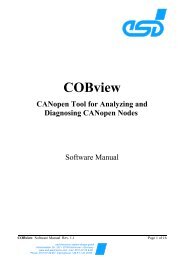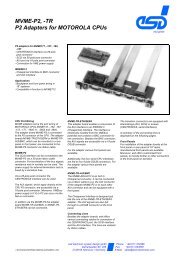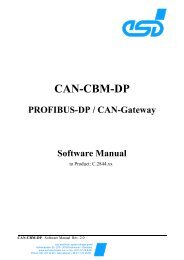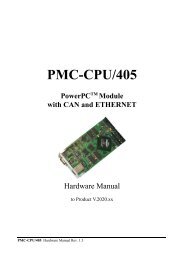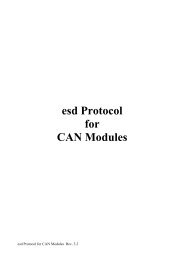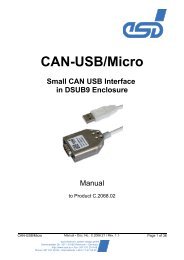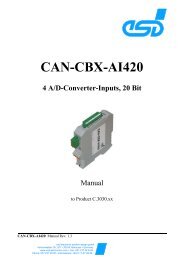Download Hardware Manual (PDF file) - esd electronics, Inc.
Download Hardware Manual (PDF file) - esd electronics, Inc.
Download Hardware Manual (PDF file) - esd electronics, Inc.
You also want an ePaper? Increase the reach of your titles
YUMPU automatically turns print PDFs into web optimized ePapers that Google loves.
CAN-CBM-COM1<br />
CAN-CBM-COM1 <strong>Hardware</strong> <strong>Manual</strong> Rev. 1.1<br />
CAN - RS-232-,<br />
RS-422-, RS-485-<br />
or TTY-Interface<br />
<strong>Hardware</strong> - <strong>Manual</strong>
Document <strong>file</strong>:<br />
Date of Print: 30.10.2002<br />
Described PCB Version: AI410 Rev. 1.1<br />
Changes in the chapters<br />
I:\texte\Doku\MANUALS\CAN\Cbm\CBM_COM1\Englisch\COM1_11H.en9<br />
The changes in the user’s manual listed below affect changes in the hardware as well as changes in the<br />
description of the facts only.<br />
Chapter Changes versus previous version<br />
-<br />
- -<br />
<strong>Manual</strong> extended for CAN-CBM-COM1 CANopen-to-Serial for CANopen<br />
firmware<br />
Technical details are subject to change without further notice.<br />
CAN-CBM-COM1 <strong>Hardware</strong> <strong>Manual</strong> Rev. 1.1
CAN-CBM-COM1 <strong>Hardware</strong> <strong>Manual</strong> Rev. 1.1<br />
N O T E<br />
The information in this document has been carefully checked and is believed to be entirely reliable. <strong>esd</strong><br />
makes no warranty of any kind with regard to the material in this document, and assumes no<br />
responsibility for any errors that may appear in this document. <strong>esd</strong> reserves the right to make changes<br />
without notice to this, or any of its products, to improve reliability, performance or design.<br />
<strong>esd</strong> assumes no responsibility for the use of any circuitry other than circuitry which is part of a product<br />
of <strong>esd</strong> gmbh.<br />
<strong>esd</strong> does not convey to the purchaser of the product described herein any license under the patent rights<br />
of <strong>esd</strong> gmbh nor the rights of others.<br />
<strong>esd</strong> electronic system design gmbh<br />
Vahrenwalder Str. 207<br />
30165 Hannover<br />
Germany<br />
Phone: +49-511-372 98-0<br />
Fax: +49-511-372 98-68<br />
E-mail: info@<strong>esd</strong>-<strong>electronics</strong>.com<br />
Internet: www.<strong>esd</strong>-<strong>electronics</strong>.com<br />
USA / Canada<br />
<strong>esd</strong><br />
PMB 292<br />
20423 State Road 7 #F6<br />
Boca Raton, Florida 33498-6797<br />
USA<br />
Phone: +1-800-732-8006<br />
Fax: +1-800-732-8093<br />
E-mail: sales@<strong>esd</strong>-<strong>electronics</strong>.com
Contents Page<br />
1. Overview ................................................................. 3<br />
1.1 Description of the Module .............................................. 3<br />
1.2 Summary of Technical Data ............................................. 5<br />
1.2.1 General technical Data .......................................... 5<br />
1.2.2 CAN- and Microcontroller Unit ................................... 6<br />
1.2.3 Serial Interface ............................................... 7<br />
1.2.4 Software Support ............................................. 7<br />
1.3 Order Information .................................................... 8<br />
2. Case View and LED Description .............................................. 9<br />
2.1 Case ............................................................... 9<br />
2.2 Front View with Position of LEDs and Coding Switches ....................... 9<br />
2.3 LED Display ....................................................... 10<br />
2.3.1 State of Red and Green LED with <strong>esd</strong> Protocol ...................... 11<br />
2.3.2 State of Red and Green LED with CANopen Firmware ................ 12<br />
3. <strong>Hardware</strong> Configuration .................................................... 13<br />
3.1 PCB View with Position of the Jumpers ................................... 13<br />
3.2 Jumpers and Coding Switches .......................................... 14<br />
3.2.1 Default Settings of the Jumpers and the Coding Switches ............... 14<br />
3.2.2 Jumpers and Coding Switches of the CAN Assemblies ................. 15<br />
3.2.2.1 Configuration Field (X100) .............................. 15<br />
3.2.2.2 CAN Identifier Bits (only for <strong>esd</strong> protocol) .................. 18<br />
3.2.2.3 Node-ID (only for CANopen firmware) ..................... 18<br />
4. Description of the Assemblies ................................................ 19<br />
4.1 CAN Interface ...................................................... 19<br />
4.1.1 Bitrate ..................................................... 19<br />
1.5.2 Transmit and Receive Circuit of the CAN Interface (Physical Layer) ...... 19<br />
4.2 Serial Interface X300 (12-pin Combicon, male) ............................. 20<br />
4.2.1 Configuration ............................................... 20<br />
4.2.2 Connection of the Serial Interfaces at DSUB9 Connector ............... 21<br />
4.2.2.1 The RS-232 Interface .................................. 21<br />
4.2.2.2 The RS-422 Interface .................................. 22<br />
4.2.2.3 The RS-485 Interface .................................. 22<br />
4.2.2.4 The TTY(20 mA) Interface ............................. 23<br />
5. Connector Assignment ..................................................... 25<br />
5.1 CAN-Interface (X200, 5-pol. Combicon-Style) ............................. 26<br />
5.2 Serial Interface (X300, 12-pol. Combicon-Style) ............................ 27<br />
6. Correctly Wiring Electrically Isolated CAN Networks ............................ 29<br />
7. Circuit Diagrams .......................................................... 33<br />
CAN-CBM-COM1 <strong>Hardware</strong> <strong>Manual</strong> Rev. 1.1 1
2<br />
This page is intentionally left blank.<br />
CAN-CBM-COM1 <strong>Hardware</strong> <strong>Manual</strong> Rev. 1.1
1. Overview<br />
1.1 Description of the Module<br />
C<br />
A<br />
N<br />
B<br />
U<br />
S<br />
X200<br />
X300<br />
electrical isolation<br />
Physical<br />
CAN<br />
Layer<br />
ISO11898<br />
Power Supply<br />
24 V (DC)<br />
Coding Switches<br />
+5 V=<br />
DC/DC-<br />
Converter<br />
+5 V=<br />
CAN 2.0B<br />
Watchdog<br />
Digital<br />
I/O Ports<br />
RAM<br />
µC<br />
505C<br />
Firmware<br />
Flash EPROM<br />
Digital<br />
I/O Ports<br />
Fig. 1.1.: Block diagram of CAN-CBM-COM1-Module<br />
Overview<br />
TTY-Interface<br />
RS-485-Interface<br />
RS-422-Interface<br />
RS-232-Interface<br />
Add-On<br />
Plug-In<br />
Serial Interface<br />
The module CAN-CBM-COM1 offers the linking of the CAN net to a serial interface. The module can<br />
be equipped with the serial interfaces RS-232, RS-422, RS-485 or TTY. In the standard version the<br />
plug-in-place is equipped with an RS-232 driver and for the other interfaces with piggybacks.<br />
The CAN-CBM-COM1 module operates with a local microcontroller of C505 type, which has an<br />
integrated CAN controller.<br />
The CAN-CBM-COM1 CAN-to-Serial module (C.2841.02) works with the <strong>esd</strong> protocol. Beyond this<br />
the module is available as CAN-CBM-COM1 CANopen-to-Serial module (C.2841.03, C.2841.04)<br />
which works with CANopen firmware. Both modules are equipped with the same hardware and are<br />
described together in the following. Differences which result from the various software, e.g. the state<br />
of the LEDs, are described separately.<br />
The default bit rate of the CAN bus can be programmed or be changed by jumper clips on the board.<br />
The CAN identifier of the CAN-CBM-COM1 CAN-to-Serial module is selectable via two rotary<br />
switches, accessible from the outside of the module. In addition, the identifier can be programmed via<br />
CAN bus. For the CAN-CBM-COM1 CANopen-to-Serial module the Node-ID is selectable via the two<br />
rotary switches.<br />
CAN-CBM-COM1 <strong>Hardware</strong> <strong>Manual</strong> Rev. 1.1 3<br />
option<br />
X300 Connection<br />
i
i<br />
Overview<br />
The ISO 11898-compatible CAN interface allows a maximum data transmission rate of 1 Mbit/s (max.<br />
35 m cable length).The CAN interface is electrically isolated by means of optocouplers and DC/DCconverters.<br />
An additional supervision function improves the operation safety:<br />
The watchdog timer, integrated into the microcontroller, causes an automatic RESET of the CAN<br />
module after the watchdog period has expired.<br />
4<br />
CAN-CBM-COM1 <strong>Hardware</strong> <strong>Manual</strong> Rev. 1.1
1.2 Summary of Technical Data<br />
1.2.1 General technical Data<br />
Power supply<br />
Connectors<br />
Temperature range<br />
Overview<br />
permitted voltage range: 10...30 V/DC<br />
current consumption (at 20 /C): typ. 30 mA (RS-232 operation)<br />
typ. 40 mA (RS-485 operation)<br />
X300 (Combicon-style<br />
12-pin MSTB 2,5/12-ST-08) - serial interface, power supply<br />
X200 (Combicon-style,<br />
5-pin MSTB 2.5/5-5.08) - CAN interface<br />
0...50 /C ambient temperature<br />
for CAN-CBM-COM1-T:<br />
-40 ... + 85 /C extended temperature range<br />
Humidity max. 90%, non-condensing<br />
Dimensions<br />
Weight approx. 85 g<br />
width: 25 mm<br />
height: 88 mm<br />
depth: 85 mm<br />
(including hat-rail mounting and connector projection Combicon)<br />
Table 1.2.1: General technical data<br />
CAN-CBM-COM1 <strong>Hardware</strong> <strong>Manual</strong> Rev. 1.1 5<br />
i
i<br />
Overview<br />
1.2.2 CAN- and Microcontroller Unit<br />
6<br />
CAN interface<br />
physical layer according to ISO 11898,<br />
electrical isolation by optocouplers and DC/DC converters<br />
Transfer rate selectable by jumpers or programmable between 10 kbit/s and 1 Mbit/s<br />
CAN identifier<br />
(<strong>esd</strong> protocol)<br />
<strong>esd</strong>-module no.<br />
(<strong>esd</strong> protocol)<br />
Node-ID<br />
(CANopen firmware)<br />
Microcontroller C505, OTP<br />
selectable via coding switches and jumpers or programmable,<br />
the module requires one Rx identifier and one Tx identifier at operation<br />
with default parameters<br />
selectable via coding switches or programmable<br />
selectable via coding switches<br />
EEPROM I²C-EEPROM for storage of parameters<br />
LED display four LEDs for status display of the microcontroller<br />
Table 1.2.2: Technical data of CAN- and microcontroller units<br />
CAN-CBM-COM1 <strong>Hardware</strong> <strong>Manual</strong> Rev. 1.1
1.2.3 Serial Interface<br />
Controller C505<br />
Overview<br />
Buffering of the serial data 256 byte memory in Tx- and 256 byte memory in Rx-direction<br />
Standard interface RS-232<br />
Possible interface equipment<br />
RS-232<br />
RS-422<br />
RS-485<br />
TTY-passive<br />
Handshake CTS/RTS and XON/XOFF<br />
Baudrate<br />
1.2.4 Software Support<br />
RS-232: max. 38,4 kbit/s<br />
RS-422: max. 125 kbit/s<br />
RS-485: max. 125 kbit/s<br />
TTY: typ. 1200 bit/s<br />
Table 1.2.3: Technical data of the serial interface<br />
The complete EPROM-resident communication firmware for operating the CAN-CBM-COM1-module<br />
is contained in the product package.<br />
CAN-CBM-COM1 <strong>Hardware</strong> <strong>Manual</strong> Rev. 1.1 7<br />
i
i<br />
Overview Order Information<br />
1.3 Order Information<br />
8<br />
CAN-CBM-COM1<br />
CAN-to-Serial<br />
CAN-CBM-COM1<br />
CANopen-to-Serial<br />
CAN-CBM-COM1<br />
CANopen-to-Serial<br />
Type Features Order No.<br />
Serial Interface RS-232,<br />
Power supply 10 VDC...30 VDC<br />
with <strong>esd</strong> protocol<br />
Serial Interface RS-232,<br />
Power supply 10 VDC...30 VDC<br />
CANopen firmware<br />
temperature range: 0 ... 50 /C<br />
Serial Interface RS-232,<br />
Power supply 10 VDC...30 VDC<br />
CANopen firmware<br />
temperature range: -40 ... 85 /C<br />
Instead of RS-232 with (please state clearly in order): RS-422 Adapter<br />
RS-485 Adapter<br />
TTYp-Adapter<br />
C.2841.02<br />
C.2841.03<br />
C.2841.04<br />
X.1930.02<br />
X.1930.04<br />
X.1930.06<br />
CAN-CBM-COM1-ME English manual for C.2841.02 1*) C.2841.21<br />
1*) ... If ordered together with the module, the manual is included in the product package.<br />
Table 1.3.1: Order information for module CAN-CBM-COM1<br />
CAN-CBM-COM1 <strong>Hardware</strong> <strong>Manual</strong> Rev. 1.1
2. Case View and LED Description<br />
2.1 Case<br />
LEDRxD (yellow)<br />
LED1 (red)<br />
LED2 (green)<br />
GND<br />
-<br />
GND<br />
CTS<br />
GND<br />
RTS<br />
GND<br />
-<br />
TxD<br />
RxD<br />
Error<br />
+24V<br />
Stat<br />
GND<br />
LED Display<br />
The board is installed in a polyamide case (UEGM–MSTB) by the manufacturer Phoenix Contact.<br />
The front has a 12-pin Combicon connector (MSTBT 2.5/12-ST-5.08) to connect the power supply and<br />
the serial interface.<br />
Two yellow, one red and one green LED show the current module status.<br />
The two HEX coding switches for manual configuration are on the upper case side.<br />
The CAN connection, a 5-pin Combicon connector (MSTBT2.5/5-5.08), is at the lower case side.<br />
The case can be locked onto carrier rails according to EN 50 022 (hat- rail) by means of clips at the back<br />
of the case.<br />
2.2 Front View with Position of LEDs and Coding Switches<br />
LEDTxD (yellow)<br />
Coding switch SW110 (Low)<br />
Coding switch SW111 (High)<br />
Fig. 2.2.1: Positions of LEDs and coding switches<br />
CAN-CBM-COM1 <strong>Hardware</strong> <strong>Manual</strong> Rev. 1.1 9
LED Display<br />
2.3 LED Display<br />
The module has two yellow, one red and one green LED (see page 9).<br />
The functions of both yellow LEDs are described in the following table.<br />
LED Name Colour Status of LED Status<br />
Tx LEDTxD yellow off no Tx signals are received<br />
10<br />
on Tx signals are received<br />
RxD LEDRxD yellow off no RxD signals are received<br />
on RxD signals are received<br />
Table 2.3.1: Names and displays of the yellow LEDs<br />
The red and green status LED are described in the following table.<br />
LED Name Colour<br />
Error LED1 red<br />
Stat LED2 green<br />
Table 2.3.2: Names of the red and green LED<br />
CAN-CBM-COM1 <strong>Hardware</strong> <strong>Manual</strong> Rev. 1.1
2.3.1 State of Red and Green LED with <strong>esd</strong> Protocol<br />
LED Display<br />
The table below describes the states of the green and the red LED for the CAN-CBM-COM1 CAN-to-<br />
Serial module (C.2841.02) working with the <strong>esd</strong> protocol.<br />
State of LEDs Status of CAN module<br />
green LED (Stat) - constantly on<br />
red LED (Error) - off<br />
LEDs flash:<br />
green LED (Stat) - 250 ms,<br />
red LED (Error) - 50 ms<br />
LEDs flash:<br />
green LED (Stat) - 40 ms,<br />
red LED (Error) - 40 ms<br />
LEDs flash:<br />
green LED (Stat) - 50 ms ,<br />
red LED (Error) - 250 ms<br />
green LED (Stat) - off<br />
red LED (Error) - constantly on<br />
Condition of module OK, module works with the<br />
parameters stored in the EEPROM.<br />
Condition of module OK, module works with the default<br />
parameters, because EEPROM data are faulty or<br />
deleted.<br />
actual CAN bus error<br />
The module discovered a temporary CAN bus error<br />
which is not active anymore.<br />
Voltage supply OK, all other functions of the module<br />
out of order -> microcontroller C505 does not work or<br />
an internal error did occur. Please, contact the service.<br />
Table 2.3.3: Display of the status LEDs with <strong>esd</strong> protocol<br />
CAN-CBM-COM1 <strong>Hardware</strong> <strong>Manual</strong> Rev. 1.1 11
LED Display<br />
2.3.2 State of Red and Green LED with CANopen Firmware<br />
The tables below desribe the states of the green and the red LED for the CAN-CBM-COM1 CANopento-Serial<br />
module (C.2841.03, C.2841.04) working with the CANopen firmware.<br />
12<br />
CANopen-RUN-LED<br />
State of the CAN<br />
module<br />
Single flash STOPPED -<br />
Blinking PRE-OPERATIONAL -<br />
LED on OPERATIONAL -<br />
CANopen-Error-LED<br />
LED flashes 1x<br />
(single flash)<br />
LED flashes 2x<br />
(double flash)<br />
Table 2.3.4: Display of the green CANopen-Run-LED<br />
State of the<br />
CANmodule<br />
warning limit<br />
reached<br />
Error Control<br />
Event<br />
Description<br />
Description<br />
- at least one of the error counters of the<br />
CAN controller has reached or exceeded<br />
the warning level (too many error frames)<br />
- a ‘Guard Event’ or or a ‘Heartbeat Event’<br />
has occurred<br />
LED on Bus Off - the CAN controller is bus off<br />
Table 2.3.5: Display of the red CANopen-Error-LED<br />
CAN-CBM-COM1 <strong>Hardware</strong> <strong>Manual</strong> Rev. 1.1
3. <strong>Hardware</strong> Configuration<br />
3.1 PCB View with Position of the Jumpers<br />
Fig. 3.1.1: Position of jumpers<br />
<strong>Hardware</strong> Configuration<br />
CAN-CBM-COM1 <strong>Hardware</strong> <strong>Manual</strong> Rev. 1.1 13
<strong>Hardware</strong> Configuration<br />
3.2 Jumpers and Coding Switches<br />
The coding switches for the manual configuration and the setting of the module number are on the upper<br />
side of the case (see page 9).<br />
coding switch SW 100 (Low)<br />
coding switch SW 101 (High)<br />
The arrangement of the Jumpers and the coding switches on the component layer can be taken from<br />
figure 3.1.1. (page 13).<br />
3.2.1 Default Settings of the Jumpers and the Coding Switches<br />
The respective default setting (see table below) at delivery of the board is entered.<br />
14<br />
Jumper /<br />
Coding Switch<br />
Jumper<br />
X100<br />
Coding<br />
switches<br />
SW100 - LOW<br />
SW101 - HIGH<br />
Jumper<br />
JP300...JP330<br />
Function Adjustment<br />
Configuration bit rate 125 kbit/s<br />
for <strong>esd</strong> protocol (CAN-to-Serial):<br />
CAN identifier bits id11-id4<br />
for CANopen firmware<br />
(CANopen-to-Serial):<br />
Module ID<br />
I/O-Port Configuration<br />
depending on user<br />
serial operation<br />
Don’t change these jumpers !<br />
Table 3.2.1: Default settings of the jumpers and coding switches<br />
CAN-CBM-COM1 <strong>Hardware</strong> <strong>Manual</strong> Rev. 1.1
3.2.2 Jumpers and Coding Switches of the CAN Assemblies<br />
3.2.2.1 Configuration Field (X100)<br />
1<br />
15<br />
Function of the bits:<br />
2<br />
16<br />
D7<br />
D6<br />
D5<br />
D4<br />
D3<br />
D2<br />
D1<br />
D0<br />
jumper open jumper closed<br />
<strong>Hardware</strong> Configuration<br />
Jumper X100 Bit Function<br />
Jumper closed --< Bit = ‘1’!<br />
CAN-CBM-COM1 <strong>Hardware</strong> <strong>Manual</strong> Rev. 1.1 15<br />
D7<br />
D6<br />
D5<br />
D4<br />
D3<br />
D2<br />
D1<br />
D0<br />
Mode<br />
0: CANlink<br />
1: standard<br />
CAN bit rate<br />
Default: 125 kbit/s<br />
reserved<br />
for <strong>esd</strong> protocol:<br />
Rx/Tx-Identifier code C0<br />
for CANopen firmware:<br />
reserved<br />
Table 3.2.2: Configuration of the jumper X100<br />
Mode (D7): If this jumper is inserted the CAN-CBM-COM1 module is working automatically with<br />
the CANlink protocol after a RESET in the default state. Is the jumper not inserted<br />
(default setting) the module is not automatically working with the CANlink protocol.<br />
It is also possible to activate the CANlink function by the software, if it was not<br />
automatically activated by this jumper.<br />
Jumper not inserted ... no CANlink<br />
Jumper inserted ... CANlink
<strong>Hardware</strong> Configuration<br />
Bit rate (D6-D3): Transfer rate<br />
An inserted jumper sets the corresponding bit to ‘1’, here! In the column ‘l max’ the maximum possible<br />
line length of the CAN is specified.<br />
16<br />
jumper bits C505-register<br />
D6 D5 D4 D3<br />
0<br />
0<br />
0<br />
0<br />
0<br />
0<br />
0<br />
0<br />
1<br />
1<br />
1<br />
1<br />
1<br />
1<br />
1<br />
0<br />
0<br />
0<br />
0<br />
1<br />
1<br />
1<br />
1<br />
0<br />
0<br />
0<br />
0<br />
1<br />
1<br />
1<br />
0<br />
0<br />
1<br />
1<br />
0<br />
0<br />
1<br />
1<br />
0<br />
0<br />
1<br />
1<br />
0<br />
0<br />
1<br />
0<br />
1<br />
0<br />
1<br />
0<br />
1<br />
0<br />
1<br />
0<br />
1<br />
0<br />
1<br />
0<br />
1<br />
0<br />
BTR0<br />
[HEX]<br />
00<br />
00<br />
00<br />
01<br />
01<br />
02<br />
03<br />
04<br />
45<br />
09<br />
4B<br />
18<br />
5F<br />
31<br />
00<br />
BTR1<br />
[HEX]<br />
14<br />
18<br />
1C<br />
18<br />
1C<br />
1C<br />
1C<br />
1C<br />
2F<br />
1C<br />
2F<br />
1C<br />
2F<br />
1C<br />
16<br />
bit rate<br />
[kbit/s]<br />
1000<br />
666.6<br />
500<br />
333.3<br />
250<br />
166<br />
125<br />
100<br />
66.6<br />
50<br />
33.3<br />
20<br />
12.5<br />
10<br />
800<br />
typical values of the<br />
attainable line length<br />
l max [m]<br />
37<br />
80<br />
130<br />
180<br />
270<br />
420<br />
570<br />
710<br />
1000<br />
1400<br />
2000<br />
3600<br />
5400<br />
7300<br />
59<br />
minimum<br />
attainable line<br />
length l min [m]<br />
20<br />
65<br />
110<br />
160<br />
250<br />
400<br />
550<br />
700<br />
980<br />
1400<br />
2000<br />
3600<br />
5400<br />
7300<br />
42<br />
The details in the table base on the limit values of the bit timing of the CAN protocol, the run times of the local CAN<br />
interface and the run times of the cable. The run time of the cable is presumed with approx. 5.5 ns/m. Further<br />
influences, e.g., by the terminal resistances, the specific resistance, the cable geometry or other external disturbance<br />
influences with the transfer have not been included!<br />
Table 3.2.3: Setting the transfer rate by X100<br />
CAN-CBM-COM1 <strong>Hardware</strong> <strong>Manual</strong> Rev. 1.1
Rx/Tx-Identifier-Code C0 (D0) (only for <strong>esd</strong> protocol):<br />
<strong>Hardware</strong> Configuration<br />
The CAN-CBM-COM1 module (C.2841.02) has got two identifiers in the default state: A Tx identifier<br />
and an Rx identifier. The identifier bits id11 to id4 are adjusted by the coding switches ‘LOW’ (SW100)<br />
and ‘HIGH’ (SW101) (see following chapter ‘CAN identifier bits id11...id4’).<br />
Is the CANlink protocol activated by jumper J110 or the firmware (see software manual of the module)<br />
the module additionally uses the identifier TxId2 and RxId2 for the exchange of protocol data.<br />
The lowest identifier bits distinguish between the Tx and Rx identifiers.<br />
To construct a CAN net in which two CAN-CBM-COM1 modules communicate with each other<br />
without a programming of the identifiers, it is possible to select by the jumper clip C0, which module<br />
should transmit (TxId) and which should receive on the same identifier (RxId).<br />
An adjusted jumper clip sets C0 to the value ‘1’.<br />
Identifier<br />
bits<br />
id2 id1<br />
Allocation of the CAN Tx and Rx identifiers<br />
C0 = 0<br />
(Default adjustment)<br />
C0 = 1<br />
0 0 Rx1 Tx1<br />
0 1 Tx1 Rx1<br />
1 0 (Rx2) (Tx2) The identifiers TxId2 and<br />
RxId2 are only used, if<br />
1 1 (Tx2) (Rx2) CANlink is activated!<br />
Table 3.2.4: Allocation of the CAN Rx and Tx identifiers by C0<br />
CAN-CBM-COM1 <strong>Hardware</strong> <strong>Manual</strong> Rev. 1.1 17
<strong>Hardware</strong> Configuration<br />
3.2.2.2 CAN Identifier Bits (only for <strong>esd</strong> protocol)<br />
With the coding switches ‘HIGH’(SW101) and ‘LOW’(SW100) the identifier bits id4 to id11 of the<br />
CAN identifiers of the CAN-CBM-COM1 module (CAN-to-Serial, C.2841.02) are adjusted. These 8<br />
identifier bits are identical for all channels.<br />
The distinction between the channels and the Rx and Tx identifiers occurs by the lowest 2 bits (id1, id2).<br />
The allocation to these bits can be selected by the jumper clip X100 (see preceding chapter).<br />
The identifier bit id3 has always be set to ‘0’.<br />
The composition of the CAN identifiers of the CAN-CBM-COM1 module (CAN-to-Serial) is shown<br />
below:<br />
18<br />
id11 id10 id9 id8 id7 id6 id5 id4 id3 id2 id1<br />
DIP switch ‘HIGH’ (SW101)<br />
$0...$F<br />
DIP switch ‘LOW’ (SW100)<br />
$0...$F<br />
always<br />
set to ‘0’<br />
Rx/Tx and<br />
channel<br />
selection<br />
(see page 17)<br />
Table 3.2.5: Allocation of the CAN identifier bits id11 to id4 to the coding switches<br />
If the module runs with the default parameters, the value adjusted by the coding switches also<br />
corresponds to the <strong>esd</strong> module no. (see software manual of the module).<br />
The local software of the module provides also the possibility to program all 11 bits of the identifiers of<br />
the module independently. Further information about this can be taken from the software manual of the<br />
module.<br />
Attention: The user has to secure that the identifiers of following modules are selected with an offset<br />
of +$2 (+$4, if CANlink is used), because otherwise intersections of the identifiers would<br />
arise!<br />
3.2.2.3 Node-ID (only for CANopen firmware)<br />
With the coding switches ‘HIGH’(SW101) and ‘LOW’(SW100) the Node-ID of the CAN-CBM-COM1<br />
module (CANopen-to-Serial, C.2841.03, C.2841.04 ) is set. The value range of the Node-ID is 0 to 127<br />
(0...7F h).<br />
Coding switch HIGH (SW101) Coding switch LOW (SW100)<br />
$0...$7 $0...$F<br />
Table 3.2.6: Setting of Node-ID<br />
CAN-CBM-COM1 <strong>Hardware</strong> <strong>Manual</strong> Rev. 1.1
4. Description of the Assemblies<br />
4.1 CAN Interface<br />
4.1.1 Bitrate<br />
Description of the Assemblies<br />
The transmission speed can be varied from 10 kbit/s to 1.0 Mbit/s. The selection of the bit rate is made<br />
by the configuration field X100.<br />
The local software of the module provides the possibility to reprogram the bit rate. The programmed<br />
bit rate replaces the bit rate adjusted by X100. Further information about this can be taken from the<br />
software manual of the module.<br />
A detailed overview of the possible bit rates can be taken from the description of jumper clip X100 (see<br />
page 16).<br />
1.5.2 Transmit and Receive Circuit of the CAN Interface (Physical Layer)<br />
The physical CAN interface of <strong>esd</strong> complies with the ISO 11898 standard. The connection to the bus<br />
occurs by a 5-pin Combicon connector.<br />
The voltage supply of the CAN bus is electrically isolated from the 24 V supply and the microcontroller<br />
C505.<br />
The electrical isolation of the signals to the CAN bus is realized by optocouplers.<br />
CAN-CBM-COM1 <strong>Hardware</strong> <strong>Manual</strong> Rev. 1.1 19
Description of the Assemblies<br />
4.2 Serial Interface X300 (12-pin Combicon, male)<br />
4.2.1 Configuration<br />
The serial Interface of the CAN-CBM-COM1 can be configured as RS-232, RS-422, RS-485 or TTY<br />
interface, depending on the insertion of driver (for RS-232) and piggyback (for RS-422, RS-485 and<br />
TTY).<br />
The interface is controlled by the microcontroller component C505. To buffer the serial data 256 bytes<br />
memory is supported for both data directions.<br />
The maximum possible bit rate of the serial interfaces is limited by the selected physical layer:<br />
20<br />
Physical Interface Bit Rate<br />
RS-232<br />
RS-422<br />
RS-485<br />
TTY<br />
max. ca. 38,4 kbit/s<br />
max. ca. 125 kbit/s<br />
max. ca. 125 kbit/s<br />
typical: 1200 bit/s<br />
Table 4.2.1: Bit rates of the serial interface<br />
CAN-CBM-COM1 <strong>Hardware</strong> <strong>Manual</strong> Rev. 1.1
4.2.2 Connection of the Serial Interfaces at DSUB9 Connector<br />
TxD<br />
RxD<br />
CTS<br />
RTS<br />
GND<br />
4<br />
3<br />
9<br />
7<br />
6<br />
Description of the Assemblies<br />
Below the wiring of the serial interface in relation to the data direction is shown. The figures should<br />
explain the short terms of the signals used in the appendix (connector assignment). Furthermore the<br />
circuit layouts of the various available piggybacks can be found in the appendix (circuit diagrams).<br />
4.2.2.1 The RS-232 Interface<br />
The signal description is given exemplary for the connection of the CAN-CBM-COM1 module as a<br />
modem (DCE).<br />
CAN-CBM-COM1<br />
local signal terms<br />
MSTB connector<br />
line:<br />
RxD<br />
CAN-CBM-COM1 <strong>Hardware</strong> <strong>Manual</strong> Rev. 1.1 21<br />
TxD<br />
RTS<br />
CTS<br />
GND<br />
pin numbers of the 12-pole MSTB connector<br />
pin numbers of the 9-pole DSUB socket<br />
DSUB9 socket<br />
Fig. 4.2.2: Connection scheme for RS-232 operation<br />
2<br />
3<br />
7<br />
8<br />
5<br />
Terminal<br />
(Example: PC as DTE)<br />
RxD<br />
TxD<br />
RTS<br />
CTS<br />
GND
22<br />
Description of the Assemblies<br />
4.2.2.2 The RS-422 Interface<br />
CAN-CBM-COM1 Termimal<br />
TxD<br />
RxD<br />
GND<br />
local<br />
signal terms<br />
4.2.2.3 The RS-485 Interface<br />
3<br />
5<br />
11<br />
7<br />
6<br />
Tx+<br />
Tx-<br />
Rx+<br />
Rx-<br />
GND<br />
pin numbers of the 12-pole MSTB socket<br />
Fig. 4.2.4: Connection scheme for RS-422 operation<br />
RxD<br />
TxD<br />
GND<br />
TxD 5<br />
RxD<br />
Rx/Tx-<br />
RxD<br />
RTS<br />
CAN-CBM-COM1<br />
+5V<br />
1 k<br />
150<br />
3<br />
11<br />
7<br />
Rx/Tx+<br />
TERM+<br />
TERM-<br />
1 k<br />
6<br />
GND<br />
GND GND<br />
local<br />
signal terms<br />
Terminal<br />
pin numbers of the 12-pole MSTB socket<br />
Fig. 4.2.5: Connection scheme for RS-485 operation<br />
To activate the terminal-resistance network which is on the piggyback, e.g. the pin 3 and 11 as well as<br />
pin 5 and 7 of the MSTB connector have to be connected.<br />
TxD<br />
CAN-CBM-COM1 <strong>Hardware</strong> <strong>Manual</strong> Rev. 1.1
4.2.2.4 The TTY(20 mA) Interface<br />
CAN-CBM-COM1<br />
TxD<br />
RxD<br />
local<br />
signal terms<br />
3<br />
5<br />
11<br />
7<br />
Tx+<br />
Tx-<br />
Rx+<br />
Rx-<br />
i=20mA<br />
i=20mA<br />
Description of the Assemblies<br />
i=20mA<br />
i=20mA<br />
CAN-CBM-COM1 <strong>Hardware</strong> <strong>Manual</strong> Rev. 1.1 23<br />
-U<br />
-U<br />
pin numbers of the 12-poe MSTB socket<br />
Terminal<br />
Fig. 4.2.6: Connection scheme for TTY operation (passive)<br />
RxD<br />
TxD<br />
+U<br />
+U
24<br />
This page is intentionally left blank.<br />
CAN-CBM-COM1 <strong>Hardware</strong> <strong>Manual</strong> Rev. 1.1
5. Connector Assignment<br />
GND<br />
-<br />
GND<br />
CTS<br />
GND<br />
RTS<br />
GND<br />
-<br />
TxD<br />
RxD<br />
Error<br />
+24V<br />
Stat<br />
GND<br />
Connector Assignment<br />
Serial Interface (X300)<br />
5 n.c.<br />
4 CAN HIGH<br />
2 CAN LOW<br />
1 CAN GND<br />
CAN-CBM-COM1 <strong>Hardware</strong> <strong>Manual</strong> Rev. 1.1 25<br />
3 n.c.<br />
CAN Interface (X200)<br />
Fig. 5.1.1: Position of connector X200 and X300
Connector Assignment<br />
5.1 CAN-Interface (X200, 5-pol. Combicon-Style)<br />
26<br />
Pin Position: Pin Assignment:<br />
Signal Description:<br />
CAN_L,<br />
CAN_H... CAN-signal lines<br />
CAN_GND ... reference potential of CAN-physical layer<br />
5<br />
4<br />
3<br />
2<br />
1<br />
Pin Signal<br />
5 n.c.<br />
4 CAN_H<br />
3 n.c.<br />
2 CAN_L<br />
1 CAN_GND<br />
Fig 5.1: Adapter cable 5-pole Combicon to 9-pole DSUB<br />
The 9-pin DSUB<br />
connector is<br />
assigned in<br />
accordance with<br />
CiA DS 102.<br />
CAN-CBM-COM1 <strong>Hardware</strong> <strong>Manual</strong> Rev. 1.1
5.2 Serial Interface (X300, 12-pol. Combicon-Style)<br />
Pin Position: Pin Assignment:<br />
12<br />
11<br />
10<br />
9<br />
8<br />
7<br />
6<br />
5<br />
4<br />
3<br />
2<br />
1<br />
Pin<br />
Signal<br />
RS-232<br />
Signal<br />
RS-422<br />
Connector Assignment<br />
Signal<br />
RS-485<br />
Signal<br />
TTY<br />
12 GND GND GND GND<br />
11 n.c. Rx+ Term+ Rx+<br />
10 GND GND GND GND<br />
9 CTS GND GND I2<br />
8 GND GND GND GND<br />
7 RTS Rx- Term- Rx-<br />
6 GND GND GND GND<br />
5 n.c. Tx- Tx/Rx- Tx-<br />
4 Tx n.c. n.c. I1<br />
3 RxD Tx+ Tx/Rx+ Tx+<br />
2 +24 V +24 V +24 V +24 V<br />
1 GND GND GND GND<br />
CAN-CBM-COM1 <strong>Hardware</strong> <strong>Manual</strong> Rev. 1.1 27
28<br />
This page is intentionally left blank.<br />
CAN-CBM-COM1 <strong>Hardware</strong> <strong>Manual</strong> Rev. 1.1
CAN_H<br />
CAN_L<br />
CAN_GND<br />
Shielded wire with<br />
transposed wires<br />
120 Ohm<br />
DSUB9 connector<br />
(female or male)<br />
CAN_GND<br />
DSUB9 connector<br />
(female or male)<br />
pin designation<br />
(at wire shield)<br />
pin designation<br />
1<br />
2<br />
n.c.<br />
CAN_L<br />
n.c.<br />
1<br />
2<br />
3<br />
3<br />
4<br />
n.c.<br />
n.c.<br />
4<br />
5<br />
n.c.<br />
n.c.<br />
5<br />
6<br />
7<br />
n.c.<br />
CAN_H<br />
n.c.<br />
6<br />
7<br />
8<br />
n.c.<br />
n.c.<br />
8<br />
9<br />
n.c.<br />
n.c.<br />
9<br />
connector case n.c.<br />
n.c. connector case<br />
n.c. = not connected<br />
Wiring<br />
6. Correctly Wiring Electrically Isolated CAN Networks<br />
Generally all instructions applying for wiring regarding an electromagnetic compatible installation,<br />
wiring, cross sections of wires, material to be used, minimum distances, lightning protection, etc. have<br />
to be followed.<br />
The following general rules for the CAN wiring must be followed:<br />
1.<br />
2.<br />
3.<br />
A CAN net must not branch (exception: short dead-end feeders) and has to be terminated<br />
by the wave impedance of the wire (generally 120 Ω ±10%) at both ends (between the<br />
signals CAN_L and CAN_H and not at GND)!<br />
A CAN data wire requires two twisted wires and a wire to conduct the reference potential<br />
(CAN_GND)!<br />
For this the shield of the wire should be used!<br />
The reference potential CAN_GND has to be connected to the earth potential (PE) at one<br />
point. Exactly one connection to earth has to be established!<br />
4. The bit rate has to be adapted to the wire length.<br />
5. Dead-end feeders have to kept as short as possible (l < 0.3 m)!<br />
6.<br />
7.<br />
8.<br />
When using double shielded wires the external shield has to be connected to the earth<br />
potential (PE) at one point. There must be not more than one connection to earth.<br />
A suitable type of wire (wave impedance ca. 120 Ω ±10%) has to be used and the voltage<br />
loss in the wire has to be considered!<br />
CAN wires should not be laid directly next to disturbing sources. If this cannot be avoided,<br />
double shielded wires are preferable.<br />
Wire structure Signal assignment of wire and connection of earthing and terminator<br />
CAN wire with connectors<br />
Figure: Structure and connection of wire<br />
CAN-CBM-COM1 <strong>Hardware</strong> <strong>Manual</strong> Rev. 1.1 29<br />
120 Ohm<br />
earth (PE)
Cabling<br />
30<br />
Wiring<br />
for devices which have only one CAN connector use T-connector and dead-end feeder (shorter than<br />
0.3 m) (available as accessory)<br />
CAN<br />
Board<br />
e.g. PCI/331,<br />
ISA/331,<br />
VME-CAN2, etc.<br />
Net 1<br />
Net 2<br />
Connecting<br />
CAN_GND to<br />
Protective Conductor PE<br />
PE<br />
l < 0,3 m<br />
CAN<br />
Module<br />
CDIO16/16<br />
Terminal Resistance<br />
Terminator<br />
with PE Connector<br />
T-Connector<br />
CAN<br />
Module<br />
CMIO<br />
CAN<br />
Module<br />
CAI810<br />
CAN_H<br />
CAN_L<br />
CAN_GND<br />
T-Connector<br />
l < 0,3 m<br />
CAN-SPS<br />
Interface<br />
CSC595/2<br />
or<br />
CAN-PC Board<br />
Female Connector<br />
Male Connector<br />
Male Terminator<br />
Female Terminator<br />
Terminator<br />
CAN<br />
Module<br />
CDMS4<br />
Figure: Example for correct wiring (when using single shielded wires)<br />
use external terminator, because this CAN later be found again more easily!<br />
9-pin DSUB terminator with male and female contacts and earth terminal are available as<br />
accessories<br />
Earthing<br />
CAN_GND has to be conducted in the CAN wire, because the individual <strong>esd</strong> modules are<br />
electrically isolated from each other!<br />
CAN_GND has to be connected to the earth potential (PE) at exactly one point in the net!<br />
each CAN user without electrically isolated interface works as an earthing, therefore: do not<br />
connect more than one user without potential separation!<br />
Earthing CAN e.g. be made at a connector<br />
CAN-CBM-COM1 <strong>Hardware</strong> <strong>Manual</strong> Rev. 1.1
Wire Length<br />
Wiring<br />
Optical couplers are delaying the CAN signals. By using fast optical couplers and testing each board<br />
at 1 Mbit/s, however, <strong>esd</strong> CAN guarantee a reachable length of 37 m at 1 Mbit/s for most <strong>esd</strong> CAN<br />
modules within a closed net without impedance disturbances like e.g. longer dead-end feeders.<br />
(Exception: CAN-CBM-DIO8, -AI4 and AO4 (these modules work only up to 10 m with 1 Mbit/s))<br />
Bit rate<br />
[kbit/s]<br />
1000<br />
800<br />
666.6<br />
500<br />
333.3<br />
250<br />
166<br />
125<br />
100<br />
66.6<br />
50<br />
33.3<br />
20<br />
12.5<br />
10<br />
Typical values of reachable<br />
wire length with <strong>esd</strong><br />
interface l max [m]<br />
37<br />
59<br />
80<br />
130<br />
180<br />
270<br />
420<br />
570<br />
710<br />
1000<br />
1400<br />
2000<br />
3600<br />
5400<br />
7300<br />
CiA recommendations<br />
(07/95) for reachable wire<br />
lengths l min [m]<br />
25<br />
50<br />
-<br />
100<br />
-<br />
250<br />
-<br />
500<br />
650<br />
-<br />
1000<br />
-<br />
2500<br />
-<br />
5000<br />
Table: Reachable wire lengths depending on the bit rate when using <strong>esd</strong>-CAN interfaces<br />
Examples for Suitable Types of Wire<br />
Manufacturer Type of wire Manufacturer Type of wire<br />
U.I. LAPP GmbH & Co. KG<br />
Schulze-Delitzsch-Straße 25<br />
70565 Stuttgart<br />
metrofunk<br />
KABEL-UNION GmbH<br />
Postfach 410109<br />
12111 Berlin<br />
UNITRONIC ®-BUS LD,<br />
UNITRONIC ®-BUS FD P LD<br />
LiYCY 2 x 0,38 mm², LiYCY 2 x 0,5 mm²,<br />
LiYCY 2 x 0,75 mm², LiYCY 2 x 1,0 mm²,<br />
1P x AWG 22 C, 1P x AWG 20 C<br />
Alcatel Kabelmetal<br />
Kabelkamp 20<br />
30179 Hannover<br />
ConCab Kabel GmbH<br />
Äußerer Eichwald<br />
74535 Mainhardt<br />
DUE 4401, DUE 4001,<br />
DUE 4402<br />
1 x 2 x 0,22 mm²<br />
Order no.: 93022016<br />
(UL approved)<br />
CAN-CBM-COM1 <strong>Hardware</strong> <strong>Manual</strong> Rev. 1.1 31
32<br />
Wiring<br />
This page is intentionally left blank.<br />
CAN-CBM-COM1 <strong>Hardware</strong> <strong>Manual</strong> Rev. 1.1
7. Circuit Diagrams<br />
Circuit Diagrams<br />
The <strong>PDF</strong>-<strong>file</strong> of this document does not contain the circuit diagrams. The circuit diagrams are shipped<br />
on request.<br />
CAN-CBM-COM1 <strong>Hardware</strong> <strong>Manual</strong> Rev. 1.1 33


